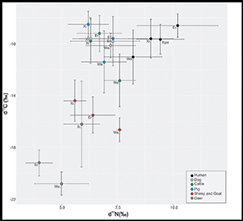Crossref Citations
This article has been cited by the following publications. This list is generated based on data provided by
Crossref.
Wang, Xueye
Roberts, Patrick
Tang, Zihua
Yang, Shiling
Storozum, Michael
Groß, Marcus
and
Fernandes, Ricardo
2021.
The Circulation of Ancient Animal Resources Across the Yellow River Basin: A Preliminary Bayesian Re-evaluation of Sr Isotope Data From the Early Neolithic to the Western Zhou Dynasty.
Frontiers in Ecology and Evolution,
Vol. 9,
Issue. ,
2021.
ANNUAL BIBLIOGRAPHY.
Early China,
Vol. 44,
Issue. ,
p.
555.
Smith, Monica L.
2021.
The process of complex societies: dynamic models beyond site-size hierarchies.
World Archaeology,
Vol. 53,
Issue. 1,
p.
122.
Tao, Dawei
Liu, Fei
Ren, Guang
Richards, Michael P.
and
Zhang, Guowen
2021.
Complexity of agricultural economies in the Yiluo region in the late Neolithic and bronze age (3500–221 BC): An integrated stable isotope and archeobotanical study from the Tumen site, North China.
International Journal of Osteoarchaeology,
Vol. 31,
Issue. 6,
p.
1079.
Tao, Dawei
Zhang, Ruijin
Xu, Junjie
Wu, Qian
Wei, Qingli
Gu, Wanfa
and
Zhang, Guowen
2022.
Agricultural extensification or intensification: Nitrogen isotopic investigation into late Yangshao agricultural strategies in the middle Yellow River area.
Journal of Archaeological Science: Reports,
Vol. 44,
Issue. ,
p.
103534.
He, Keyang
Lu, Houyuan
Jin, Guiyun
Wang, Can
Zhang, Hai
Zhang, Jianping
Xu, Deke
Shen, Caiming
Wu, Naiqin
and
Guo, Zhengtang
2022.
Antipodal pattern of millet and rice demography in response to 4.2 ka climate event in China.
Quaternary Science Reviews,
Vol. 295,
Issue. ,
p.
107786.
Jaffe, Yitzchak
Campbell, Roderick
and
Shelach-Lavi, Gideon
2022.
Shimao and the Rise of States in China.
Current Anthropology,
Vol. 63,
Issue. 1,
p.
95.
He, Keyang
Lu, Houyuan
Zhang, Jianping
and
Wang, Can
2022.
Holocene spatiotemporal millet agricultural patterns in northern China: a dataset of archaeobotanical macroremains.
Earth System Science Data,
Vol. 14,
Issue. 10,
p.
4777.
Tao, Dawei
Xu, Junjie
Wu, Qian
Gu, Wanfa
Wei, Qingli
Zhou, Yawei
Richards, Michael P.
and
Zhang, Guowen
2022.
Human diets, crop patterns, and settlement hierarchies in third millennium BC China: Bioarchaeological perspectives in Zhengluo region.
Journal of Archaeological Science,
Vol. 145,
Issue. ,
p.
105647.
He, Keyang
Yu, Xiaoshan
Shen, Caiming
and
Lu, Houyuan
2022.
Coupled and decoupled legumes and cereals in prehistoric northern and southern China.
Frontiers in Plant Science,
Vol. 13,
Issue. ,
Cheshmehzangi, Ali
and
Tang, Tian
2022.
China’s City Cluster Development in the Race to Carbon Neutrality.
p.
147.
2022.
Isis Current Bibliography of the History of Science and Its Cultural Influences 2022.
Isis,
Vol. 113,
Issue. S1,
p.
1.
Wang, Xin
Zhao, Zhijun
Zhong, Hua
Chen, Xianglong
and
Hu, Yaowu
2022.
Manuring and land exploitation in the Central Plains of late Longshan (2200–1900 BCE) China: Implications of stable isotopes of archaeobotanical remains.
Journal of Archaeological Science,
Vol. 148,
Issue. ,
p.
105691.
Wolff, Alice C.
Westbrook, Anna S.
and
DiTommaso, Antonio
2022.
In the ruins: the neglected link between archaeology and weed science.
Weed Science,
Vol. 70,
Issue. 2,
p.
135.
Hu, Qingbo
Dong, Ningning
Hu, Songmei
Qin, Xiaoli
and
Yuan, Jing
2023.
Meat procurement strategy from the Neolithic to the Bronze Age in the Guanzhong region of Shaanxi Province, China.
Frontiers in Earth Science,
Vol. 11,
Issue. ,
Li, Yue
Cheng, Ruoxin
Huang, Zexian
Mao, Xiaolu
Liu, Kexin
Wang, Qianwen
Hou, Furen
Mao, Ruilin
and
Zhang, Chengrui
2023.
Animals in Mortuary Practices of Bronze-Age Pastoral Societies: Caprine Use at the Site of Dunping in Northwestern China.
Animals,
Vol. 13,
Issue. 24,
p.
3794.
Brunson, Katherine
and
Lander, Brian
2023.
Deer and Humans in the Early Farming Communities of the Yellow River Valley: A Symbiotic Relationship.
Human Ecology,
Vol. 51,
Issue. 4,
p.
609.
Jaffe, Yitzchak
2023.
Food in Ancient China.
Wang, Qianwen
Liu, Kexin
Zhai, Linlin
Liu, Bin
Sun, Han
and
Li, Yue
2023.
Animal resource exploitation in the northern Guanzhong region during the mid-to-late Holocene: A zooarchaeological case study of the Xitou site.
Frontiers in Earth Science,
Vol. 10,
Issue. ,
Jaang, Li
2023.
Erlitou: The Making of a Secondary State and a New Sociopolitical Order in Early Bronze Age China.
Journal of Archaeological Research,
Vol. 31,
Issue. 2,
p.
209.
